Liquid and Solid Embolic Agents in Gonadal Veins
- PMID: 33918908
- PMCID: PMC8069975
- DOI: 10.3390/jcm10081596
Liquid and Solid Embolic Agents in Gonadal Veins
Abstract
Male varicocele and pelvic congestion syndrome (PCS) are common pathologies with high predominance in young patients, having a high impact on the quality of life and infertility. Lately, the use of different endovascular embolization techniques, with various embolizing agents, shows good technical results and clinical outcomes. With the aim of presenting the "state of the art" of endovascular techniques for the treatment of male varicocele and PCS, and to discuss the performance of the different embolic agents proposed, we conducted an extensive analysis of the relevant literature and we reported and discussed the results of original studies and previous meta-analyses, providing an updated guide on this topic to clinicians and interventional radiologists. We have also underlined the technical aspects for the benefit of those who approach this type of interventional treatment. Our review suggests promising results in both the endovascular embolic treatment of male varicocele and PCS; for varicocele, a success rate of between 70% and 100% and a recurrence rate of up to 16% is reported, while for PCS it has been found that technical success is achieved in almost all cases of endovascular treatment, with a highly variable recurrence rate based on reports. Complications are overall rather rare and are represented by periprocedural pain, migration of embolic media and vascular perforations: severe adverse events have been reported very rarely.
Keywords: embolic agent; interventional radiology; pelvic congestion syndrome; varicocele; vein embolization.
Conflict of interest statement
The authors declare no conflict of interest.
Figures
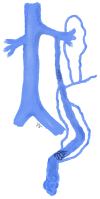
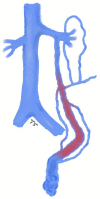

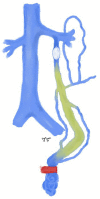
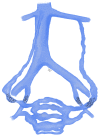
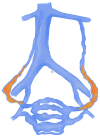
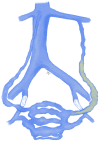

Similar articles
-
Gonadal vein embolization: treatment of varicocele and pelvic congestion syndrome.Semin Intervent Radiol. 2008 Sep;25(3):261-70. doi: 10.1055/s-0028-1085927. Semin Intervent Radiol. 2008. PMID: 21326516 Free PMC article.
-
Endovascular transcatheter embolization of recurrent postsurgical varicocele: anatomic reasons for surgical failure.Acta Radiol. 2015 Jan;56(1):63-9. doi: 10.1177/0284185113519624. Epub 2014 Jan 10. Acta Radiol. 2015. PMID: 24413222 Clinical Trial.
-
Endovascular interventions in the treatment of pelvic congestion syndrome caused by May-Thurner syndrome.J Vasc Surg Venous Lymphat Disord. 2020 Nov;8(6):1049-1057. doi: 10.1016/j.jvsv.2020.02.012. Epub 2020 Mar 31. J Vasc Surg Venous Lymphat Disord. 2020. PMID: 32241734
-
Surgical or radiological treatment for varicoceles in subfertile men.Cochrane Database Syst Rev. 2021 Apr 23;4(4):CD000479. doi: 10.1002/14651858.CD000479.pub6. Cochrane Database Syst Rev. 2021. PMID: 33890288 Free PMC article.
-
Diagnosis and treatment of the pelvic congestion syndrome.J Vasc Surg Venous Lymphat Disord. 2015 Jan;3(1):96-106. doi: 10.1016/j.jvsv.2014.05.007. Epub 2014 Jun 25. J Vasc Surg Venous Lymphat Disord. 2015. PMID: 26993690 Review.
Cited by
-
Non-Adhesive Liquid Embolic Agents in Extra-Cranial District: State of the Art and Review of the Literature.J Clin Med. 2021 Oct 21;10(21):4841. doi: 10.3390/jcm10214841. J Clin Med. 2021. PMID: 34768362 Free PMC article. Review.
-
An injectable and dual-crosslinked hydrogel for controlled and permanent vascular embolization.Bioact Mater. 2025 Jul 9;53:141-160. doi: 10.1016/j.bioactmat.2025.06.049. eCollection 2025 Nov. Bioact Mater. 2025. PMID: 40688022 Free PMC article.
-
Coil occlusion combined with sclerotherapy versus N-butyl-2-cyanoacrylate embolization in patients with pelvic venous disorders: A single-center retrospective study.J Vasc Surg Venous Lymphat Disord. 2025 Jul;13(4):102241. doi: 10.1016/j.jvsv.2025.102241. Epub 2025 Mar 28. J Vasc Surg Venous Lymphat Disord. 2025. PMID: 40158623 Free PMC article.
-
Varicocoele embolization with sclerosing agents leads to lower radiation exposure and procedural costs than coils: Data from a real-life before and after study.Andrology. 2022 May;10(4):694-701. doi: 10.1111/andr.13162. Epub 2022 Feb 26. Andrology. 2022. PMID: 35179316 Free PMC article.
-
Antegrade embolization of varicocele with cyanoacrylate glue: a case report.CVIR Endovasc. 2024 Jun 27;7(1):52. doi: 10.1186/s42155-024-00446-6. CVIR Endovasc. 2024. PMID: 38935311 Free PMC article.
References
Publication types
LinkOut - more resources
Full Text Sources
Other Literature Sources

